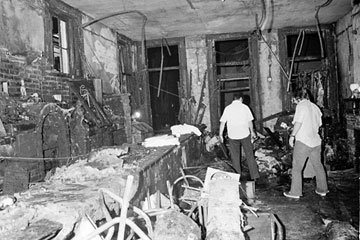
This is a view inside the UpStairs bar following a flash fire that left 29 dead and 15 injured, June 25, 1973. Most of the victims were found near the windows in the background. The bar is located in the New Orleans French Quarter.
(3 of 5)
When Perry tried to find a site to hold the memorial, churches closed their doors. New Orleans was then 47% Catholic, but the archdiocese refused to help. Baptist churches hung up on him. An Episcopal church led by a friend of Larson's held a prayer service but declined to host the memorial after the presiding bishop received dozens of angry phone calls and letters of protest. "It was like that over and over again," Perry, now 72, says. "My biggest disappointment as a Christian minister to this day was the churches, the way they responded to me."
Just months earlier, two less deadly fires in New Orleans received far more attention. In November, six died in a blaze at the Rault Center, and eight died in a January arson at a downtown Howard Johnson's. In both cases, Mayor Moon Landrieu and Governor Edwin Edwards issued statements of condolence. Philip Hannan, the city's powerful Catholic archbishop who eulogized President John F. Kennedy and Senator Robert Kennedy and later presided over Jacqueline Onassis' funeral, offered his support. After the Upstairs fire, Hannan was silent, while public officials limited their statements to calls for improving the city's fire code.
For the gay community, Larson's mannequin-like body, which remained visible in the window past midnight, became a symbol of the city's indifference toward them. Given that reception, it's understandable why so many were skeptical of the police investigation.
A Trail Runs Cold
Homicide detectives interviewed survivors at Charity Hospital shortly after the fire was put out. They spent nearly 12 hours on the scene and soon had more than 50 officers assigned to the case. Witness accounts were conflicting, which was not surprising given that many people were badly injured, traumatized and still drunk, but those who saw the fire erupt all used language consistent with arson to describe it--one compared it to a fireball, another to a Molotov cocktail. Police found an accelerant: a 7-oz. can of Ronsonal lighter fluid, left empty in the stairwell. A clerk at a nearby Walgreens said someone purchased an identical can of lighter fluid not long before the fire started, but she could not identify the person.
The investigation lasted two months. At the end of a 64-page report issued in August, the department concluded, "Although there is speculation of arson, as of the writing of this report, there is no physical evidence to indicate anything other than this being a fire of undetermined origin." The coroner classified all 32 deaths as "accidental fire fatalities." Three bodies were never identified. Sam Gebbia, then 26, was a lead investigator on the case. He says today that the chief of detectives' inflammatory statement about the Upstairs patrons was taken out of context (the department apologized soon after) and that the police put its full weight behind the case. "In my whole experience in the homicide division, that never played into anything," he says. "That was one of the biggest multideaths that I had ever been on the scene of. We pulled out every stop."
A teenager, David Dubose, confessed to the fire but quickly recanted. He was cleared after his alibi was confirmed, and he passed a polygraph test.
